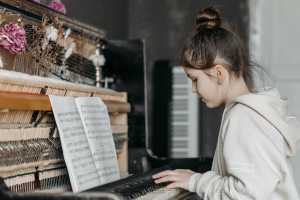The language of vibration and rhythm in music encompasses the profound connection between sound, physical sensations, and human expression.
It explores how individuals, particularly deaf and mute pianists, engage with music through alternative sensory channels.
While music is conventionally associated with auditory perception and spoken language, these musicians have discovered remarkable ways to connect with and interpret music using the piano as their medium.
Vibration in Music
Vibration is the physical phenomenon that gives rise to the sounds we perceive and the tactile sensations we feel while listening to or playing music.
In musical instruments, such as strings, drums, or vocal cords, vibration is responsible for generating sound. When an instrument is played, it sets its components into motion, causing them to vibrate. These vibrations create waves of pressure in the surrounding air, which we perceive as sound.
Vibration is closely tied to pitch in music. The frequency of vibration determines the pitch of a musical tone. Higher frequencies result in higher pitches, while lower frequencies produce lower pitches. For example, when a guitar string is plucked, its vibrations at a faster rate produce a higher-pitched sound compared to slower vibrations that create lower-pitched tones.
Resonance occurs when an object vibrates sympathetically in response to the vibrations of another object. In music, resonance plays a crucial role in enhancing and amplifying sound. For instance, when a singer hits a resonant note, it can cause a piano string or a guitar body to vibrate sympathetically, producing a richer and more sustained sound.

Pavel Danilyuk / Pexels
Sensory Substitution Devices and Technologies
Sensory substitution devices and technologies can also be applied in the context of online piano lessons to assist individuals with sensory impairments. While traditional piano learning heavily relies on auditory feedback, sensory substitution can help overcome these limitations and enable individuals to learn and play the piano
For individuals with hearing impairments, visual-to-tactile sensory substitution can be employed to enhance their learning experience. Online piano lesson platforms can incorporate technologies that convert visual cues, such as sheet music or virtual keyboards, into tactile feedback. This can be achieved through haptic devices that provide vibrations or other tactile sensations, allowing learners to feel the notes, rhythms, and other musical elements.
Online piano lesson platforms can include real-time transcription or captioning features that convert spoken instructions or feedback from instructors into text. This enables learners to read the instructions, explanations, and feedback directly, ensuring they have access to all the necessary information for their piano learning journey.
In addition to sensory substitution, individuals with sensory impairments can utilize specific assistive technologies designed for piano playing. For example, there are piano keyboards equipped with visual indicators or light-up keys that provide visual cues for the notes being played. These technologies can be integrated into online piano lessons, facilitating the learning process for individuals with sensory disabilities.
By incorporating sensory substitution devices and technologies into online piano lessons, individuals with sensory impairments can overcome barriers and actively participate in learning and playing the piano.
Sign Language in Bridging the Communication Gap Between Deaf Pianists and Audiences
Sign language serves as a visual language that allows deaf individuals to express themselves, communicate their musical interpretations, and connect with the audience on a deeper level.
Sign language enables the expression of emotions, thoughts, and artistic interpretations while performing. Through a combination of hand gestures, facial expressions, and body movements, they can convey the dynamics, mood, and nuances of the music they are playing. Sign language adds a visual dimension to their performance, allowing the audience to understand and connect with their artistic expression.
Sign language can be used to convey musical terms and concepts. Deaf pianists can use specific signs to indicate musical elements such as tempo, dynamics, articulation, and phrasing. This helps the audience to grasp the technical aspects of the performance and enhances their appreciation and understanding of the music being played.

Mikhail Nilov / Pexels
Music Education for Deaf and Mute Pianists
deaf and mute individuals can receive music education and pursue piano training. While traditional methods of teaching may require adaptations to accommodate their specific needs, there are approaches and techniques that can be employed to make music education accessible and fulfilling for deaf and mute pianists.
Visual communication methods, such as sign language or visual cues, can be used to convey instructions, explanations, and musical concepts to deaf and mute pianists. Teachers can utilise visual aids, demonstrations and gestures to effectively communicate musical techniques and concepts.
Exploring How Deaf and Mute Pianists Convey Emotions Through Their Performances
Deaf and mute pianists have the remarkable ability to transmit emotions through their performances, despite the challenges they face with traditional modes of communication.
One of the ways they express their feelings and emotions is through body language. Facial expressions, hand movements, and body posture are ways to communicate the emotional content of the music.
Deaf pianists, in particular, can feel the vibrations and resonance of the piano through their fingers, hands, and body. They use these tactile sensations to enhance their emotional expression while playing.
The way they touch the keys, apply pressure, and control the timing of notes can convey a wide range of emotions, from gentleness to intensity.
Final thoughts
In the world of music, communication transcends traditional barriers, and deaf and mute pianists exemplify this. Their ability to convey emotions through their piano playing demonstrates the power of music as a universal language that can be understood and appreciated by all.
By embracing their unique abilities and employing various means of expression, deaf and mute pianists enrich the musical landscape and create truly meaningful and impactful performances.
